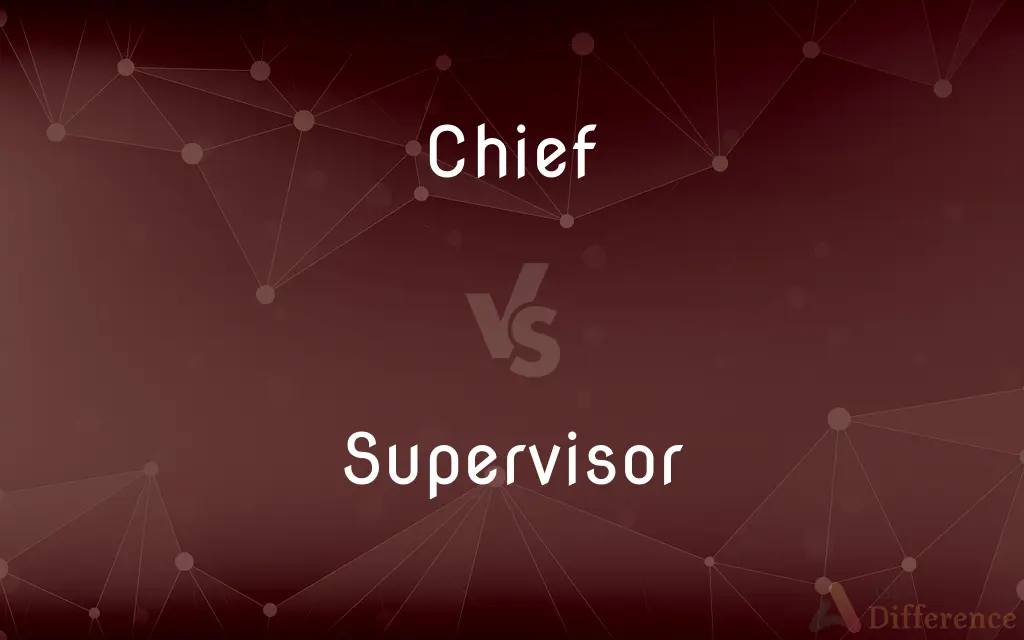Chief vs. Supervisor — What's the Difference?
By Urooj Arif & Maham Liaqat — Updated on March 27, 2024
Chief denotes a high-ranking or leading position, while Supervisor refers to someone overseeing the work of others, often with a focus on day-to-day activities.

Difference Between Chief and Supervisor
Table of Contents
ADVERTISEMENT
Key Differences
The title of Chief, such as Chief Executive Officer (CEO) or Chief Financial Officer (CFO), typically signifies a top-level leadership position within an organization. Chiefs are responsible for setting strategies, making major corporate decisions, and overseeing the entire operation of an organization or department. On the other hand, a Supervisor is a mid-level management role focused on overseeing the day-to-day work of employees, ensuring tasks are completed efficiently and effectively.
While Chiefs operate at the strategic level, making decisions that affect the organization's long-term direction, Supervisors are more involved in the tactical aspects of management, dealing with the implementation of these strategies and ensuring the smooth operation of day-to-day activities. Chiefs are often removed from the day-to-day details, focusing on broader organizational goals, whereas Supervisors have a hands-on role, directly engaging with staff and addressing immediate issues and challenges.
Chiefs typically have a broader scope of responsibility, encompassing multiple departments or the entire organization, and their decisions can have a significant impact on the organization's success. Supervisors, in contrast, usually have a more limited scope, focusing on a specific team or department. The success of a Supervisor is often measured by the efficiency, productivity, and morale of their team, as well as their ability to meet short-term objectives and contribute to the organization's broader goals.
The paths to becoming a Chief versus a Supervisor also differ significantly. Becoming a Chief often requires extensive experience, a strong track record of leadership and success in relevant fields, and, frequently, advanced education. In contrast, the role of Supervisor may be accessible to individuals with less experience but who possess strong organizational, communication, and leadership skills, and who have demonstrated competence in their specific area of work.
Despite these differences, both Chiefs and Supervisors play crucial roles in the functioning of any organization. Chiefs provide the vision and strategic direction needed to navigate the organization towards its long-term goals, while Supervisors ensure that this vision is implemented effectively on a day-to-day basis, managing teams to achieve immediate objectives and contribute to the organization's overall success.
ADVERTISEMENT
Comparison Chart
Role
Top-level leadership, setting strategies and overall direction.
Mid-level management, overseeing day-to-day operations of a team.
Responsibilities
Making major decisions, influencing organizational culture and direction.
Managing team dynamics, assigning tasks, evaluating performance.
Scope
Broad, affecting the entire organization or major departments.
Focused on a specific team or department.
Impact
Long-term organizational success and strategy implementation.
Short-term objectives, team efficiency, and productivity.
Path to Role
Requires extensive experience, often advanced education.
May require less experience, focuses on organizational and leadership skills.
Compare with Definitions
Chief
A top executive role responsible for strategic decisions and leadership.
The Chief Executive Officer (CEO) led the company to international success.
Supervisor
Plays a key role in implementing company policies and strategies.
The warehouse supervisor introduced new procedures to enhance inventory management.
Chief
Requires a comprehensive understanding of the organization and industry.
The Chief Technology Officer (CTO) introduced innovative tech solutions to enhance productivity.
Supervisor
Manages and oversees the daily work of employees within a department.
The production supervisor ensured all tasks met quality standards.
Chief
Holds significant influence over the organization’s direction.
As Chief Financial Officer, she restructured the company’s debt to drive growth.
Supervisor
Directly involved in team dynamics and performance management.
As a customer service supervisor, she improved team efficiency and customer satisfaction.
Chief
Often part of the highest echelon of an organization.
The Chief Operating Officer (COO) oversees day-to-day operations at a strategic level.
Supervisor
Provides training, feedback, and support to team members.
The sales supervisor trained new employees in effective sales techniques.
Chief
Focuses on the organization's long-term goals and sustainability.
The Chief Marketing Officer (CMO) developed a groundbreaking strategy to increase market share.
Supervisor
Responsible for meeting departmental targets and objectives.
Under the new supervisor, the team consistently exceeded their quarterly goals.
Chief
A leader or ruler of a people or clan
Chief Banawi
The chief of the village
Supervisor
A supervisor, or also known as foreman, boss, overseer, facilitator, monitor, area coordinator, or sometimes gaffer, is the job title of a low level management position that is primarily based on authority over a worker or charge of a workplace. A supervisor can also be one of the most senior in the staff at the place of work, such as a Professor who oversees a PhD dissertation.
Chief
An ordinary consisting of a broad horizontal band across the top of the shield.
Supervisor
A person who supervises a person or an activity.
Chief
Most important
Chief among her concerns is working alone at night
The chief reason for the spending cuts
Supervisor
One who supervises.
Chief
One who is highest in rank or authority; a leader.
Supervisor
One who is in charge of a particular department or unit, as in a governmental agency or school system.
Chief
A chief petty officer.
Supervisor
One who is an elected administrative officer in certain US counties and townships.
Chief
(Nautical) The chief engineer of a ship.
Supervisor
(management) A person with the official task of overseeing the work of a person or group, or of other operations and activities.
Chief
(Slang) A supervisor; a boss.
Supervisor
A person who monitors someone to make sure they comply with rules or other requirements set for them.
Chief
(Heraldry) The upper section of a shield.
Supervisor
(US) In certain states, an elected member of the governing body for a county which is called the board of supervisors.
Chief
Highest in rank, authority, or office
The chief scientist in the lab.
Supervisor
(computing) A process responsible for managing other processes.
Chief
Most important or influential
The chief ingredients in the stew. See Usage Note at absolute.
Supervisor
One who supervises; an overseer; an inspector; a superintendent; as, a supervisor of schools.
Chief
A leader or head of a group of people, organisation, etc.
All firefighters report to the fire chief.
Supervisor
A spectator; a looker-on.
Chief
(heraldry) The top part of a shield or escutcheon; more specifically, an ordinary consisting of the upper part of the field cut off by a horizontal line, generally occupying the top third.
Supervisor
One who supervises or has charge and direction of
Chief
The principal part or top of anything.
Supervisor
A program that controls the execution of other programs
Chief
An informal term of address.
Chief
An informal term of address for a Native American or First Nations man.
Chief
Primary; principal.
Negligence was the chief cause of the disaster.
Chief
(Scotland) Intimate, friendly.
Chief
To smoke cannabis.
Chief
The head or leader of any body of men; a commander, as of an army; a head man, as of a tribe, clan, or family; a person in authority who directs the work of others; the principal actor or agent.
Chief
The principal part; the most valuable portion.
The chief of the things which should be utterly destroyed.
Chief
The upper third part of the field. It is supposed to be composed of the dexter, sinister, and middle chiefs.
Chief
Highest in office or rank; principal; head.
Chief
Principal or most eminent in any quality or action; most distinguished; having most influence; taking the lead; most important; as, the chief topic of conversation; the chief interest of man.
Chief
Very intimate, near, or close.
A whisperer separateth chief friends.
Chief
A person who is in charge;
The head of the whole operation
Chief
A person who exercises control over workers;
If you want to leave early you have to ask the foreman
Chief
Most important element;
The chief aim of living
The main doors were of solid glass
The principal rivers of America
The principal example
Policemen were primary targets
Common Curiosities
Can someone be both a Chief and a Supervisor?
While the roles have distinct responsibilities, in smaller organizations, a Chief may also directly manage teams, effectively combining both roles.
What is the role of a Supervisor?
A Supervisor oversees the day-to-day operations and management of a team, focusing on task assignment, performance evaluation, and ensuring team efficiency and productivity.
What skills are important for a Chief?
Strategic thinking, leadership, decision-making, and an extensive understanding of the industry and organization are crucial for a Chief.
How do Chiefs and Supervisors contribute to organizational success?
Chiefs contribute by providing strategic vision and direction, while Supervisors ensure this vision is executed effectively through daily management of team activities.
What skills are essential for a Supervisor?
Organizational, communication, leadership, and problem-solving skills are essential for effectively managing a team as a Supervisor.
What are the reporting lines for Chiefs and Supervisors within an organization?
Chiefs typically report to the Board of Directors or the CEO, depending on the organizational structure, while Supervisors report to middle or senior management, such as Department Heads or Chiefs.
What defines a Chief in an organization?
A Chief is defined by their top-level leadership position, responsible for setting strategic direction, making major decisions, and overseeing the organization or key departments.
Is experience more important for becoming a Chief or a Supervisor?
Both roles value experience, but becoming a Chief typically requires a higher level of experience and often advanced education, reflecting the role's broader responsibilities.
Do Chiefs get involved in day-to-day operations like Supervisors?
Generally, Chiefs focus on strategic planning and decision-making rather than day-to-day operations, which are the primary responsibility of Supervisors.
How does one transition from a Supervisor to a Chief?
Transitioning from a Supervisor to a Chief involves gaining extensive experience, demonstrating leadership and strategic decision-making skills, and often pursuing further education or certifications.
What educational background is typically required for Chiefs and Supervisors?
Chiefs often have advanced degrees in business or their specific field, whereas Supervisors might need a bachelor's degree or specific vocational training related to their area of supervision.
What impact do Chiefs and Supervisors have on the company culture?
Chiefs play a critical role in shaping and steering the company culture through policies and strategic initiatives, whereas Supervisors help to implement and reinforce this culture on a daily basis within their teams.
Can the success of a Supervisor affect their potential to become a Chief?
Yes, the success of a Supervisor, demonstrated through leadership, achieving targets, and effective team management, can be a stepping stone to higher management roles, including Chief positions.
How do Chiefs and Supervisors contribute to innovation within an organization?
Chiefs encourage innovation by setting the vision and providing resources, while Supervisors are crucial in fostering an environment where team members can contribute ideas and experiment within their roles.
How do Chiefs and Supervisors handle conflict within the organization?
Chiefs address conflict from a strategic perspective, making decisions that affect the organization's direction, while Supervisors handle conflict directly within their teams to maintain productivity and morale.
Share Your Discovery

Previous Comparison
Johnathan vs. Jonathan
Next Comparison
Mistranscribe vs. MistranscribedAuthor Spotlight
Written by
Urooj ArifUrooj is a skilled content writer at Ask Difference, known for her exceptional ability to simplify complex topics into engaging and informative content. With a passion for research and a flair for clear, concise writing, she consistently delivers articles that resonate with our diverse audience.
Co-written by
Maham Liaqat















































